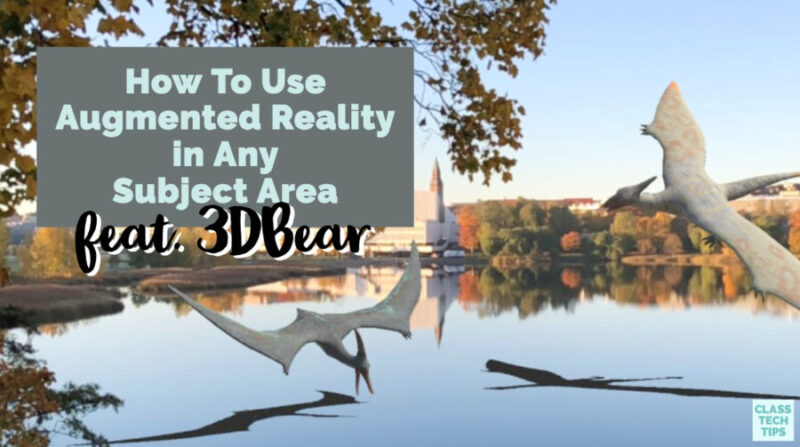Does augmented reality have a place in your classroom? Across subject areas and grade levels, educators are bringing augmented reality learning experiences to their students. But if you’ve wondered how to use augmented reality in your classroom, I’m excited to share a handful of ideas and a fantastic back-to-school promotion to get you started.
I was first introduced to the possibilities of augmented reality in education at my very first ISTE Conference in San Antonio, Texas, in 2013. I already had an idea of what augmented looked like and what it might be able to do. But most of my “experience” was from watching science fiction movies. After that first conference, my wheels started spinning about potential use cases for augmented reality. However, it was hard to find clear curriculum connections that made AR more than a “wow” factor in my classroom.
Augmented Reality in Education
Last year I connected with the folks behind 3DBear, an AR tool that turns teachers and students into creators. I’ve talked about 3DBear on the blog in the past, including its connection to Web 3.0, ways to use augmented reality for storytelling, and project ideas for science classrooms. 3DBear can help support phenomenon-based learning too.
If you’re a regular follower of the blog or listener of the podcast, you’ve probably seen me use the phrase “tasks before apps.” With any open-ended creation tool, for as much as I’m excited to see what it does, I care way more about how teachers and students can use it in the classroom.

So in addition to sharing 3DBear’s special back-to-school promotion, I also want to make sure you have some ideas to customize and tailor to the needs of your students. First off, here are the details about the promotion. From July 30th to September 30th, 2019, if you sign up for the free trial from within the 3DBear app, you’ll automatically get one month extra, for a total of two months free.
Head straight to your favorite App Store and download the 3DBear app for iOS (iPad & iPhone) and Android (on the Google Play Store).
How To Use Augmented Reality
If you’re interested in ways to use augmented reality in your classroom this year, I have a few subject area-specific ideas to share with you. It’s important to remember that there isn’t one right way to integrate technology into your instruction, and these are ideas you can customize. Of course, you might have goals for using AR with students that go beyond traditional curriculum connections, like building empathy or problem-solving.
AR Activity Ideas
English Language Arts: Students can read a short passage and recreate a scene. You might ask them to write a paragraph that goes along with their augmented reality representation. This is a great opportunity for students to make connections to the text. For a collaborative project, a class can create a video retelling scenes from a book they’ve read as a call. You might even have small groups of students create a video for different scenes. Then, they can play these scenes in the order they appear in the book. Here is a link to a video based on Goodnight Moon.

Science: 3DBear has an extensive collection of dinosaur elements that can fly around your students’ screens. This feature makes it an excellent choice for discussing habitats and parts of the world once inhabited by these creatures. In the video below, you get a feel for what it looks like to place a T-Rex outside of your school building!
Social Studies: Students can explore festivals from around the world and create a scene with a special celebration. 3DBear has a large collection of elements for students to add to their scenes, or they can design their own.
Math: You might ask students to redesign a space in their school or community, and use augmented reality to represent their design proposal. Students can use Tinkercad to build elements with specific, scaled measurements to add to 3DBear.
Design Thinking with Augmented Reality
With 3DBear, students can explore design thinking principles within an augmented reality space. After accepting a challenge and researching the topic, students can discuss potential solutions and obstacles and decide on their design. 3DBear has collections of elements students can use to layer a virtual object on top of a real place. By layering elements over a space, students can create an augmented reality experience. Students can also design elements using third-party integrations.
Then students can compose a description of their planned response to a problem and build a scene in augmented reality in 3DBear. 3DBear provides users with a few different options for documenting and presenting their final augmented reality scene too. So students can create a video or snap a picture to go along with their written description.
Standards for Teaching Augmented Reality
When reviewing your standards and learning goals for the upcoming school year, you might not see the term augmented reality listed in any state-wide or school-wide documents. However, a quick review of the Standards for Mathematical Practice in the Common Core reminds us that “model with mathematics” can take many forms — including an augmented reality model.
The same is true when reviewing the English Language Arts Anchor Standards and the goals you have for students as speakers and listeners this school year. Here is a link to a slide deck with high level ELA, Science, Math, and Social Studies standards. You can see how building stories and solutions in augmented reality hits so many of the areas we want children to learn.
In the video above, you can see some of the ways augmented reality is used in schools across the country. I had the opportunity to meet with Susan Sclafani last year. She is a passionate educator at a school just a few miles from where I grew up. It was so exciting to hear about the ways she is using 3DBear in her classroom. Thinking about how to use augmented reality this school year? I definitely encourage you to explore this dynamic tool!
Ready to dive in? Just download the app and sign up for a free trial! Head straight to your favorite App Store. Use this link to find the 3DBear app for iOS (iPad & iPhone) and Android (on the Google Play Store).







